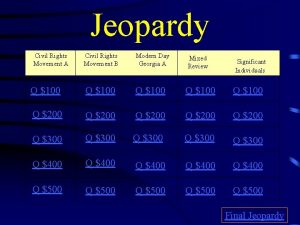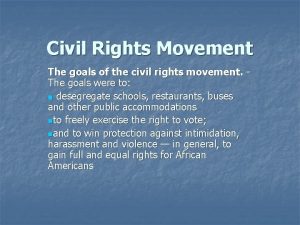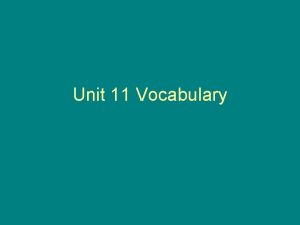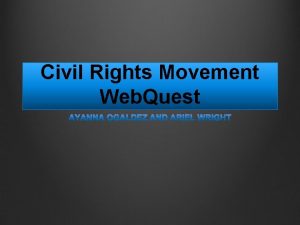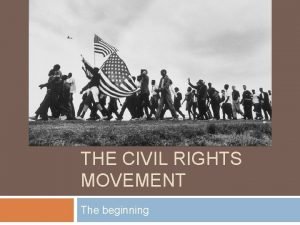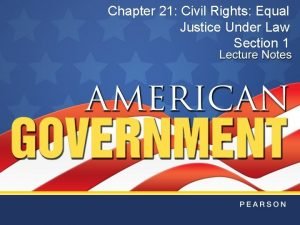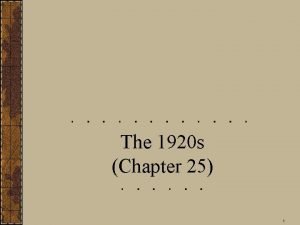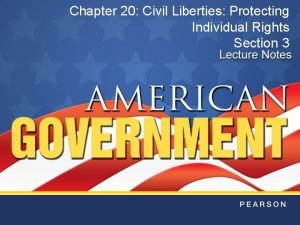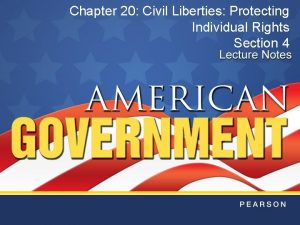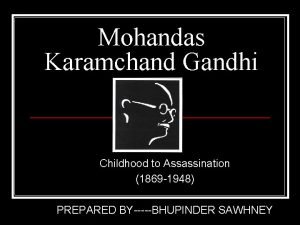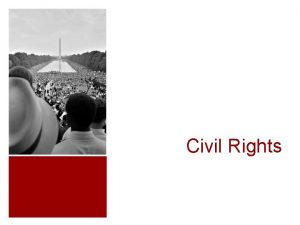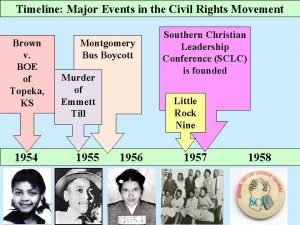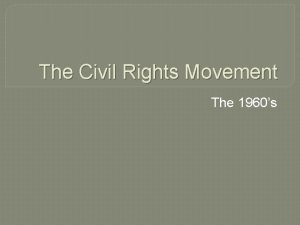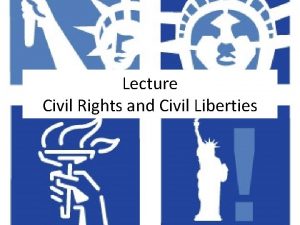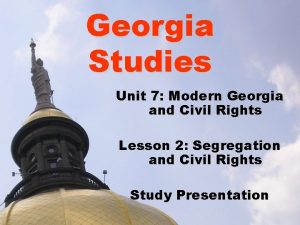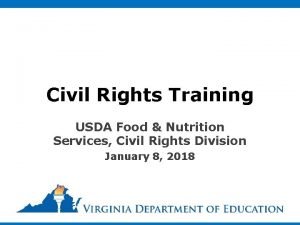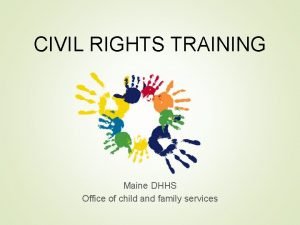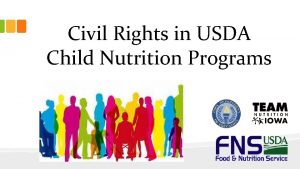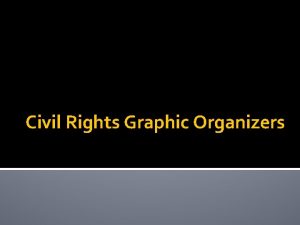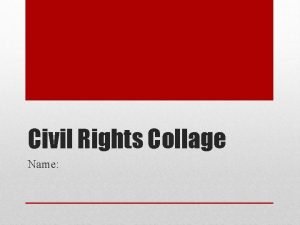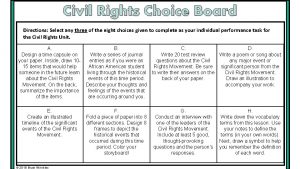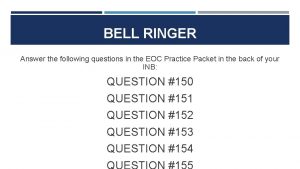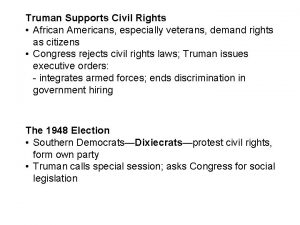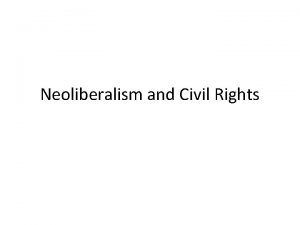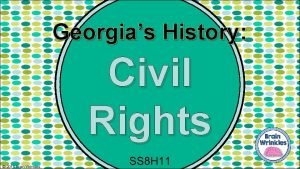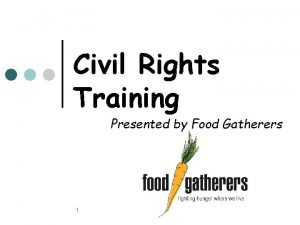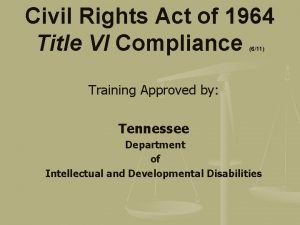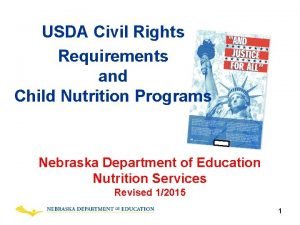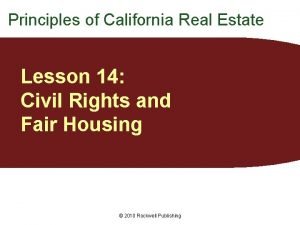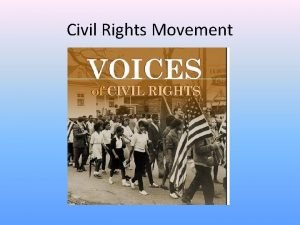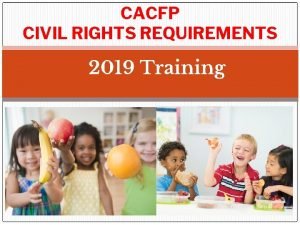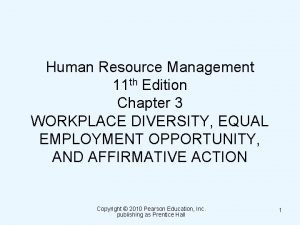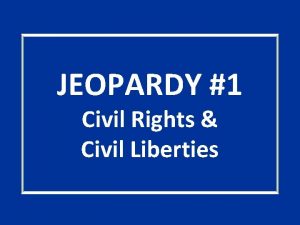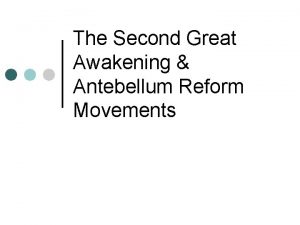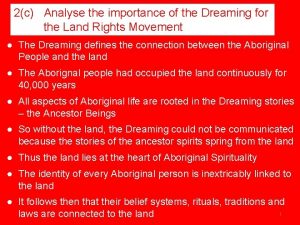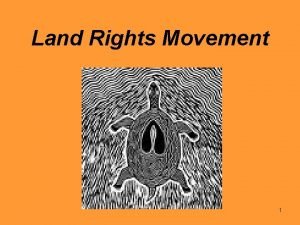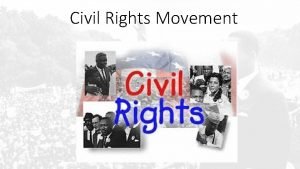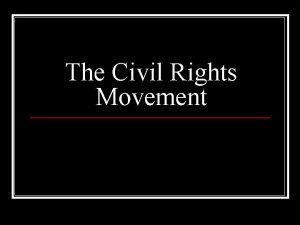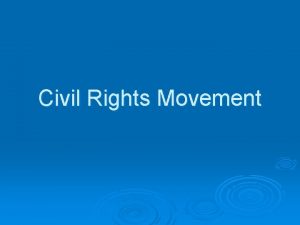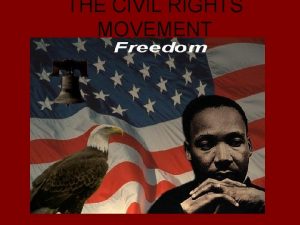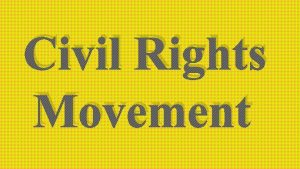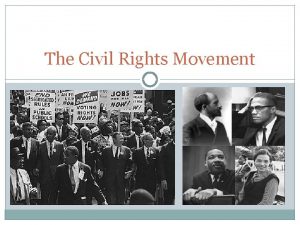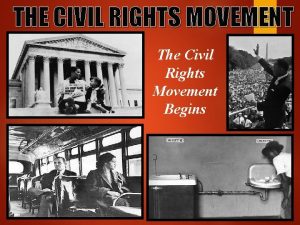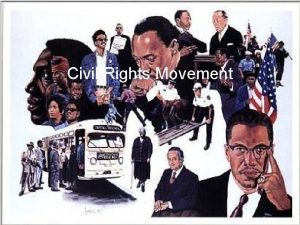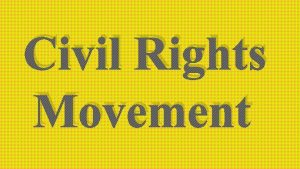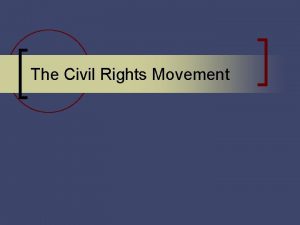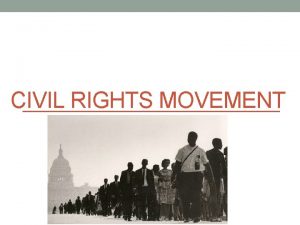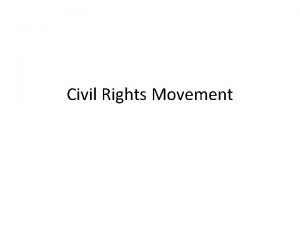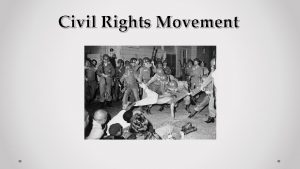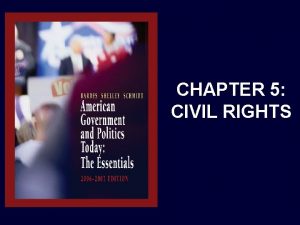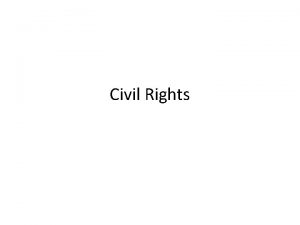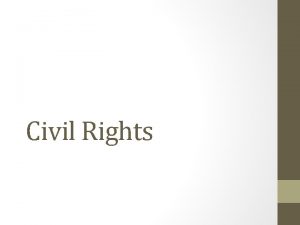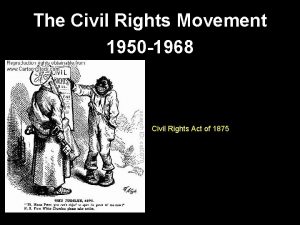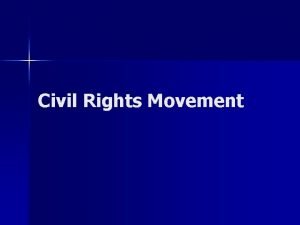Chapter 14 The Civil Rights Movement Civil Rights





































































- Slides: 69

Chapter 14 The Civil Rights Movement

Civil Rights Movement… Ø 1950 s and 1960 s – started as a grassroots movement by ordinary people who wanted to end racial injustice Ø No one group organized all of the events or actions – several major groups formed to share info. and coordinate activities Ø Each group had its own goals, priorities and strategies

Supreme Court Cases Sweatt v Painter – State of Texas had violated the 14 th amendment by establishing a separate but not equal all black college Ø Mc. Laurin v Oklahoma – U of O had admitted Mc. Laurin but would not allow him equal access to the library, dining hall etc. . . Ø Hernandez v Texas – ended the exclusion of Mexican Americans from serving on trial juries Ø Brown v Topeka, Kansas Board of Education Ø Brown II – “With all deliberate speed” Ø

Laying the Groundwork… Ø The struggle for racial equality became clear during WWII and had some victories in the 1940 s and 1950 s – like Brown v. Board of Education

NAACP…. . Ø National Association for the Advancement of Colored People Ø Founded in 1909 from the Niagara Movement Ø Interracial organization – worked to secure full legal equality for all Americans and to remove obstacles that kept them from voting Ø WEB Du. Bois (1 st AA to earn a Doctorate Degree from Harvard) was a founding member & Dir. of publicity and research

Ø NAACP challenged laws that kept AA from exercising their full rights as citizens – wrote new laws and filed lawsuits Ø Unsuccessfully tried to pass anti-lynching laws – but kept public focus on the issue Ø Won battles for desegregation in housing and education Ø This group appealed mostly to educated middle and upper class AA and liberal white Americans Ø Critics said that it was out of touch with the economic issues that faced most AA


National Urban League… Ø Founded in 1911 – helped AA move to major cities – AA moved out of the South – helped to find homes and jobs and made sure that they were treated fairly at work Ø Sought out migrant families on ship docks and train stations – helped them find apartments Ø Got Employers and Union Leaders to provide training to AA workers so that they had the skills to retain their jobs and hopefully advance

CORE… Ø Congress of Racial Equality – founded in 1942 – goal was to created change through peaceful confrontation Ø Interracial group – worked during WWII to end segregation in cities like Baltimore, Chicago and Denver Ø Director James Farmer did not take a paycheck so that the organization would have more money to work with

Southern Christian Leadership Conference… Ø SCLC – founded by Martin Luther King Jr after the Montgomery Bus Boycott in 1957 Ø Introduced nonviolent protest Ø Focused its work in the South – group was populated by Southern AA Church leaders Ø Martin Luther King Jr. would become a national figure through this organization

Martin Luther King Jr…. Ø Born in Atlanta, GA in 1929 – grew up during the height of segregation in the south – Father and Grandfather were Baptist Preachers Ø Eloquent public speaker – graduated early from High School – Went to Morehouse College in Atlanta – earned a Divinity Degree at Crozer Seminary in Pennsylvania and earned a Doctoral Degree in Theology from Boston University in 1955 Ø Met and married his wife Coretta Scott


Ø Influenced by Mohandas Gandhi who preached nonviolence in India’s struggle against Great Britain – Those who fought for resistance must peacefully refuse to obey unjust laws – must remain nonviolent no matter the violence against them – this required great poise and courage

Montgomery, Alabama… Ø MLK - 1 st job as a Pastor at age 27 in Montgomery Ø Chosen to lead the year long bus boycott Ø Began training volunteers in nonviolent protest Ø Bus boycotters were taught the 6 rules for taking a nonviolent approach – included pray, be loving, if pushed do not push back, do not interfere in violence against others but pray for their deliverance, if you feel you can not take it, walk instead of riding the bus for another week

SIX PRINCIPLES OF NONVIOLENCE Ø (1. ) Nonviolence is not passive, but requires courage; (2. ) Nonviolence seeks reconciliation, not defeat of an adversary; (3. ) Nonviolent action is directed at eliminating evil, not destroying an evil-doer; (4. ) A willingness to accept suffering for the cause, if necessary, but never to inflict it; (5. ) A rejection of hatred, animosity or violence of the spirit, as well as refusal to commit physical violence; and (6. ) Faith that justice will prevail. Ø

Ø For the next 11 yrs. King would be in the center of every major civil rights action Ø Won the Nobel Peace Prize in 1964 Ø He was attacked physically, verbally and was jailed many times - death threats were frequent Ø He was assassinated in Memphis, Tenn. on his hotel balcony in April 1968 at the age of 39 by James Earl Ray – a white Southerner – Ray was convicted and sentenced to 99 years in prison – died in prison in 1998.

I have a Dream

SNCC…. Ø Student Nonviolent Coordinating Committee called SNCC or “snick” Ø Founded in 1960 in Raleigh, NC as a group for college students in the SCLC Ø Started out as interracial but that changed Ø It shifted focus on civil rights leadership away from church leaders only Ø SNCC wanted immediate change – now

Ø Robert Moses – one of the leaders of SNCC – math teacher from Harlem – very soft spoken – very well respected Ø Anne Moody- worker for the NAACP, CORE, SNCC from Centerville, Mississippi endured much because of her beliefs – beaten, jailed, humiliated, ostracized by her family for her beliefs

Sit-Ins…. Ø CORE staged the 1 st sit in at the Jack Spratt Coffee house in Chicago in 1943 Ø Sat at segregated lunch counter or other public places and refused to leave until they were served – SNCC joined in Ø Sit ins often turned violent with only the AA protestors being arrested Ø SCLC supported sit ins – arrests were “Badges of Honor” – 1961 70, 000 students participated in sit ins – 3, 600 were jailed


Texas Southern University: Silencing Houston's Jim Crow – youtube. com

Little Rock 9 Ø 1957 – in accordance with Brown – 9 AA students were registered to attend Central High School Ø Gov. Orval Faubus blocked their attendance with National Guardsmen Ø Pres. Eisenhower warned Faubus to not interfere Ø Eisenhower also sent US Army troops to escort the students into the school


Freedom Rides… Boynton v. Virginia (1960)– Bus stations, waiting areas and interstate buses could no longer segregate Ø CORE & SNCC set up Freedom Rides –to test whether or not southern states would obey the Supreme Court ruling and allow AA to exercise their new rights Ø 13 people – 7 black & 6 white – most in their 40 s and 50 s – seated as interracial pairs all over the bus Ø One would always sit in the back to follow the law in case of arrests or violence Ø

Violence for the Riders… May 4, 1961 – 1 st Freedom Ride from Washington DC to New Orleans, LA – 13 riders both black and white – boarded a bus headed south Ø Only minor conflicts at first – then at Atlanta the group split to begin the ride into the deep South Ø Violence was planned by Police who were members of the KKK – mobs would be given 15 minutes to do as much violence as possible before police would step in – an FBI/KKK member were involved as well Ø

Anniston, Alabama – May 14, 1961 – Bus tires were slashed at terminal – when the bus had to stop – it was firebombed. Mob members held the door shut in hopes of burning/killing all riders. An explosion caused the mob to disperse and riders were able to escape the bus. Riders were beaten as they exited the bus. Injured riders refused care at the hospital and were secretly taken away to prevent further violence by the mob that gathered outside the hospital.

Freedom Ride inspires participants to create change – youtube. com

Birmingham and Montgomery Ø Ø Ø 2 nd Bus reached Anniston – all riders were beaten by KKK members and left them semi-conscious in the back of the bus Riders are severely beaten by KKK in Birmingham – assisted by police officers – when the riders exited the bus – a mob waited with baseball bats, tire irons and bike chains – white riders were harshly singled out for their support Injured riders were taken to a local hospital which refused to treat them – new riders were brought in to continue on State Police were order by JFK to escort the riders to Montgomery–State Police stopped the escort at the city limits Riders were dragged off the bus and beaten as well in Montgomery while the local police watched A rally takes place with MLK speaking in support of the riders – mobs threatened to firebomb the church – JFK steps in

Gov. Patterson relents and order Nat’l Guard to disperse the mob Ø Deal made between JFK and Gov. in AL and MS Ø New riders make it to Jackson and are peaceably arrested – continued to bring in new replacements until jails were full – sent to State Pennitentiary – placed on death row – when the riders refused to stop singing – they were treated horribly Ø Freedom Rides continued for several months throughout the south Ø Atty Gen Robert Kennedy forced the ICC to implement the law or face severe fines Ø

Albany Movement… Oct. 1961 – group of AA began a year protest marches called the Albany Movement (Georgia) Ø They wanted the desegregation of all bus terminals Ø Martin Luther King Jr. went to Albany to help Ø Albany Police Chief Laurie Pritchett followed a plan of “nonviolent opposition” keeping police violation of civil rights out of public view kept the Albany Movement from gaining public support or sympathy Ø The movement died out at the end of 1962 Ø

Integration at “Ole Miss”… Ø Sept 1962 – James Meredith – black Air Force veteran was a student at Jackson State College but wanted to go to all white University of Mississippi “Ole Miss” Ø Denied admission by Ole Miss based on race – NAACP got involved Ø Argued between the Governor and the Justice Department

Ø Angry white protestors destroyed the vehicles that brought the Marshalls to campus Ø Violence erupted on campus – tear gas was used – 2 bystanders were killed and hundreds were injured – JFK sent army troops to restored order & Marshalls escorted James Meredith to class


Clash in Birmingham… Ø Rev. Fred Shuttlesworth - leader of the Alabama Christian movement for Human Rights in Birmingham (40% AA) invited MLKing to visit in April 1963 Ø King referred to Birmingham as the most segregated city in the country Ø Boycotts of local stores and integration of churches were planned – many worried about the outcome and tried to negotiate

Reporters wanted to know how long King planned to stay he replied like Moses… until Pharaoh “let his people go” Ø Eugene “Bull” Conner -The Police commissioners reply – “I got plenty of room in the jail. ” Ø Campaign began quietly with marches and sitins Ø Marches apparently violated a rule about parades without permits – arrests were made – King included Ø At his release – King decided to let children join the campaign Ø

Ø He believed that this would test the conscience of the Police and the nation Ø Bull Conner arrested 900 children and used high pressure fire hoses which could tear the bark from trees on the protestors Ø Trained police dogs attacked the marchers arms and legs Ø When marchers fell to the ground – the police beat them with their clubs and took them to jail Ø Children were placed in cells with felons

Children's Crusade Birmingham 1963 – youtube. com


Ø Television cameras caught the violence that occurred in Birmingham – everyone who watched was appalled by the violence against the peaceful protestors Ø The protestors won – a compromise was reached – desegregation of the public facilities took place and an interracial committee was set up to aid communication Ø Birmingham was just one example of the success of nonviolent protest

JFK on Civil Rights… Senator Kennedy made arrangements to help MLKing after he had been sentenced to 4 months of hard labor – Word raced that JFK had helped MLK and the AA people rallied to Kennedy , giving him the much needed votes to win in 1960 Ø However JFK once in office moved slowly on Civil Rights issues like fair housing – he did not want to alienate southern Democrats Ø The violent response to the Freedom Rides embarrassed JFK when he met with Khrushchev Ø How did the great benevolent US look to the rest of the world as is beat its own people? Ø

Ø Kennedy introduced a strong civil rights bill to congress that prohibited segregation in public places, banned discrimination in places that received federal funds and pushed for complete school desegregation Ø Powerful southern segregationists fought the bill and kept it from coming up for a vote

March on Washington… Ø Civil rights leaders proposed a march on the capital to draw attention to JFKs bill Ø August 1963 – 200, 000 people came from all over the US – Sammy Davis Jr. entertainer, Jackie Robinson – 1 st AA pro baseball player, James Baldwin - novelist attended Ø The march was peaceful – after many songs and speeches – Dr. King gave his best known speech “I Have a Dream…”

LBJ on Civil Rights… Ø In the State Congress and as a Texan- LBJ had supported many segregation laws Ø But as the Senate Majority Leader – he had worked successfully to get a civil rights bill passed in 1957 Ø As President – he used all of his skills to get Kennedy’s bill passed Ø LBJ had a friend evoke cloture and ended a filibuster in the Senate – getting the bill passed in June 1964

Civil Rights Act of 1964… Title I – banned the use of different voting standards for blacks and whites Ø Title II – Banned discrimination in public accommodations – hotels, movies, arenas Ø Title III - Prohibited state and local gov’ts from denying access to public facilities on grounds of race, religion, or ethnicity Ø Title IV - Encouraged the desegregation of public schools and authorized the U. S. Atty General to file suits to enforce Ø Title VI – Allowed the withholding of federal funds from programs if there was discrimination Ø Title VII – Banned discrimination based on race, sex, religion, and nationality in Jobs – also set up the EEOC (Equal Employment Opportunity Ø

Freedom Summer… Ø Voter registration drive organized in Mississippi by civil rights leaders in 1964 Ø AA and white volunteers, mostly college students, worked during Freedom Summer Ø White Mississippians were angry about the Civil Rights Act Ø KKK held rallies to intimidate the volunteers

Violence in 1964 Ø 4 civil rights workers were killed (1 in a head on collision) Ø 3 Black Mississippians were murdered Ø 4 were critically wounded Ø 80 Freedom Summer workers were beaten Ø 1, 062 people were arrested Ø 37 Churches were bombed or burned Ø 30 Black homes or businesses were bombed or burned

Ø 3 volunteers were reported missing – Chaney, Goodman, Schwerner Ø Requests for an FBI investigation were ignored for 2 days – Robert Kennedy ordered the FBI to Mississippi Ø Investigation/search went on for 7 weeks Ø Most white Mississippians believed the whole thing was a hoax set up to draw attention – 8 other bodies were found Ø Late summer – FBI discovered the 3 bodies buried in a new earthen dam close to where their burned out station wagon had been found

1964 Democratic Convention… Ø MFDP – Mississippi Freedom Democratic party was set up to gain AA vote representation – the other Dem. Party represented only the white vote Ø LBJ would allow the MFDP to participate in the 1968 Dem. Convention but not the 1964 convention Ø He knew something had to be done to eliminate discrimination

The Selma March… Ø Police were arresting AA as they waited in line to register to vote in Selma, Alabama Ø King organized a protest march to go from Selma to Montgomery Ø 3 marches started the journey but only the 3 rd reached Montgomery with the help of court action

March 7, 1965 – 600 marchers were attacked by state and local police with clubs and tear gas as television cameras caught all of the violence – called “Bloody Sunday” Ø March 9, 1965 – 2, 500 marchers held a ceremonial march – lead by King to the E. P. Bridge and then back to the park – a prayer vigil was held – as to not alienate the only slightly sympathetic judge – after the vigil had broken up – three white ministers were beaten by segregationists – one died from his injuries – James Reeb – after a white hospital turned him away and sent him to a black hospital Ø March 21, 1965 – Judge upheld the SCLC’s right to petition/march – the march took 5 days – 4000 Army, Nat’l Guard, US Marshalls acted as escorts - a celebration was held at the end of the journey – the numbers of participants swelled to 25, 000 Ø

The Voting Rights Act of 1965… Ø The death of 4 black girls in a church bombing and everything else acted as an impetus in the passing of this law Ø LBJ had the Voting Rights Act passed in the summer of 1965 Ø Federal officials could register voters in places where local officials were blocking voting registration by AA Ø This eliminated literacy tests/other barriers Ø More than 400, 000 AA were registered

Malcolm X Ø Malcolm Little – born in Omaha, Nebraska – Father was a preacher who preached the “back to Africa” speech of Marcus Garvey – When his Dad died – Malcolm moved around to the ghettos of Detroit, Boston and NY Ø Little turned to crime and was arrested for burglary and served 7 yrs. in prison Ø While in prison he joined the Nation of Islam referred to as Black Muslims – the group preached black segregation and self -help


Black Nationalism… Ø Nation of Islam was founded in 1933 by Elijah Muhammad Ø Taught that Allah would bring about a black nation – a union of all nonwhite people and that the key to self knowledge was knowing your enemies Ø The enemy of the Nation of Islam was white society

Ø Members did not seek change but waited for Allah to create a Black Nation Ø They worked hard to become economically self sufficient and to lead righteous lives Ø When Malcolm Little was released from prison in 1952 – he changed his name to Malcolm X (the name that slaveowner’s gave) Ø Spent 12 years as a minister for the Nation of Islam – he was a very fiery speaker and preached for black nationalism – separate identity and racial unity of African Americans

Opposition to Integration… Malcolm X opposed all forms of integration Ø He thought that all of the nonviolent protest was a waste and that sit-ins and marches were pointless Ø Elijah Muhammad and Malcolm X did not agree on tactics and split Ø Malcolm X formed the Muslim Mosque Inc. Ø He made a pilgrimage to Mecca and it changed his life – he returned to the US and joined the civil rights movement Ø His change of heart had earned him some enemies in the Nation of Islam Ø

Assassination of Malcolm X… Ø Feb. 1965 – Malcolm X was shot to death at a rally in New York Ø Three members of the Nation of Islam were charged with the murder Ø He became a martyr like influence on some members of SNCC

Black Power… Ø Stokley Carmichael – a SNCC leader had heard Malcolm X speak – as he rose in the leadership ranks of SNCC – the group became more militant Ø He was tired of non-violence – he called on all SNCC to carry guns and he rejected all white activists who wanted to join the group Ø June 1966 Greenwood, Mississippi – the split in the civil rights movement became very obvious….

Ø Dr. Kings followers were singing “We shall overcome…” and Carmichaels followers were chanting “WE SHALL OVERRUN…” Ø He jumped on the back of a truck – pushing the crowd into a frenzy getting them to chant “We want Black Power” Ø His goals for AA were “to unite, recognize their heritage, to build a sense of community, to begin to define their own goals, to lead their own organizations and support those organizations”


Black Panthers… Ø Bobby Seale and Huey Newton formed the Black Panthers in 1966 Ø They demanded that the Federal Gov’t rebuild the nation’s ghettos after years of neglect Ø Used Mao Zedong’s slogan “Power flows from the barrel of a gun” Ø Even with their violent clashes with police – the group set up day care centers and free breakfast programs


Black is Beautiful… Created to promote racial pride Ø Supported dressing in clothes that were traditional African patterns, fabrics, and colors Ø Hairstyles were more cultural – Afros, corn rows, shaved heads Ø

Riots in the Streets… De jure segregation – racial segregation created by law Ø De facto segregation – racial segregation created by social conditions – like poverty Ø Poor conditions in both the north and south existed – housing, schools, jobs Ø White police officers in black neighborhoods were like “occupying soldiers in a bitterly, hostile nation” Ø Eventually anger and frustration evolved into riots Ø

Ø 1964 – riots erupted in Rochester, NYC, and parts of New Jersey Ø Aug. 11, 1965 - Watts (in Los Angeles, CA) Police pulled over a 21 yr. old Black man for drunk driving – a crowd of AA began to gather Ø At first everything was normal but then the man resisted arrest and a police officer panicked and used his riot baton to subdue the man Ø This action set off 6 days of rioting



Watts Riots… Ø 1, 000 s of people filled the street, burning cars and stores, looting, fighting with firefighters Ø National Guard and local police finally gained control after 6 days Ø 34 people were dead, over 1000 were injured, 3400 arrested, $40 million in damages Ø Riots spread to other cities – “Burn Baby Burn” became a new rallying cry replacing the peaceful church hymns of the earlier civil right movement
 Civil rights and civil liberties webquest
Civil rights and civil liberties webquest Rosa parks mother
Rosa parks mother Civil rights movement jeopardy
Civil rights movement jeopardy Goals of the civil rights movement
Goals of the civil rights movement Civil rights movement vocabulary
Civil rights movement vocabulary Civil rights movement webquest
Civil rights movement webquest The civil rights movement
The civil rights movement Civil rights movement essential questions
Civil rights movement essential questions Chapter 21 civil rights equal justice under law
Chapter 21 civil rights equal justice under law Chapter 20 civil liberties protecting individual rights
Chapter 20 civil liberties protecting individual rights Chapter 14 postwar prosperity and civil rights
Chapter 14 postwar prosperity and civil rights Civil rights act of 1957 apush
Civil rights act of 1957 apush Chapter 20 civil liberties protecting individual rights
Chapter 20 civil liberties protecting individual rights Chapter 20 civil liberties protecting individual rights
Chapter 20 civil liberties protecting individual rights Program of civil disobedience movement
Program of civil disobedience movement Civil right movement def
Civil right movement def Movement vs non movement area
Movement vs non movement area Define axial movement
Define axial movement Civil rights timeline of events
Civil rights timeline of events Civil rights sitins
Civil rights sitins Define civil rights
Define civil rights Unit 7 modern ga and civil rights
Unit 7 modern ga and civil rights Usda civil rights training
Usda civil rights training Civil rights training child nutrition programs
Civil rights training child nutrition programs Civil rights in child nutrition programs
Civil rights in child nutrition programs Civil rights graphic organizer
Civil rights graphic organizer Civil rights leaders collage
Civil rights leaders collage Civil rights choice board
Civil rights choice board Civil rights bell ringers
Civil rights bell ringers Truman supports civil rights
Truman supports civil rights Characteristics of civil rights
Characteristics of civil rights Civil rights cloze notes 1
Civil rights cloze notes 1 Sibley commission definition
Sibley commission definition Federally protected classes
Federally protected classes Title vi of the civil rights act of 1964
Title vi of the civil rights act of 1964 Civil rights in child nutrition programs
Civil rights in child nutrition programs Unruh civil rights act real estate
Unruh civil rights act real estate Civil rights movment
Civil rights movment Cacfp civil rights
Cacfp civil rights Title vii of the civil rights act
Title vii of the civil rights act Title vii of the civil rights act
Title vii of the civil rights act Civil rights jeopardy
Civil rights jeopardy What did the civil rights act of 1875 do
What did the civil rights act of 1875 do Women's rights movement
Women's rights movement Importance of the dreaming for the land rights movement
Importance of the dreaming for the land rights movement Dreamtime.net
Dreamtime.net Positive rights and negative rights
Positive rights and negative rights Riparian vs littoral rights
Riparian vs littoral rights Duties towards self
Duties towards self Legal rights and moral rights
Legal rights and moral rights Positive and negative rights
Positive and negative rights Negative rights
Negative rights Negative right
Negative right Negative right
Negative right Hình ảnh bộ gõ cơ thể búng tay
Hình ảnh bộ gõ cơ thể búng tay Slidetodoc
Slidetodoc Bổ thể
Bổ thể Tỉ lệ cơ thể trẻ em
Tỉ lệ cơ thể trẻ em Chó sói
Chó sói Chụp tư thế worms-breton
Chụp tư thế worms-breton Hát lên người ơi
Hát lên người ơi Môn thể thao bắt đầu bằng từ chạy
Môn thể thao bắt đầu bằng từ chạy Thế nào là hệ số cao nhất
Thế nào là hệ số cao nhất Các châu lục và đại dương trên thế giới
Các châu lục và đại dương trên thế giới Công thức tính độ biến thiên đông lượng
Công thức tính độ biến thiên đông lượng Trời xanh đây là của chúng ta thể thơ
Trời xanh đây là của chúng ta thể thơ Mật thư tọa độ 5x5
Mật thư tọa độ 5x5 Làm thế nào để 102-1=99
Làm thế nào để 102-1=99 Phản ứng thế ankan
Phản ứng thế ankan Các châu lục và đại dương trên thế giới
Các châu lục và đại dương trên thế giới


